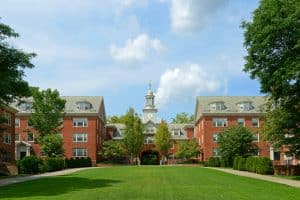What Is the Yield Rate for Brown University?
Yield rate is a crucial metric in college admissions that gauges the number of admitted students who choose to enroll at a particular institution. For Brown University, a prestigious Ivy League school, understanding its yield rate is essential in comprehending the dynamics of student enrollment.
In this article, we will delve into the definition and significance of yield rate, provide an overview of Brown University, analyze its yield rate trends, compare it to other Ivy League schools, and explore the implications this rate has on prospective students.
With a current Brown yield rate of 67%, it’s evident that the vast majority of students who apply to Brown consider it their top choice for further education. This is further demonstrated by the growing number of students applying through the binding early decision process year after year. Understanding the factors contributing to this high yield rate is integral to grasping the institution’s appeal and its position in the competitive landscape of higher education.
Understanding Yield Rate in College Admissions
Before we explore Brown University’s yield rate, let’s gain a general understanding of what this metric entails.
When it comes to college admissions, yield rate is a crucial factor that institutions consider. It represents the percentage of students who accept an offer of admission and choose to enroll at a specific college or university. In other words, it measures the conversion rate of admitted students into enrolled students. This metric is also commonly referred to as the enrollment rate.
Now, let’s delve deeper into the definition and importance of yield rate in college admissions.
Definition of Yield Rate
Yield rate, as mentioned earlier, is the percentage of students who accept an offer of admission and decide to enroll at a particular institution. It is a vital statistic for colleges and universities as it helps them assess the effectiveness of their recruitment and admission strategies.
Colleges invest significant time, effort, and resources into attracting and selecting the most promising applicants. The yield rate serves as a measure of success for these efforts. It provides valuable insights into the institution’s ability to attract and retain students.
Furthermore, the yield rate is calculated by dividing the number of students who enroll by the number of students who were offered admission. For example, if a college admitted 1,000 students and 800 of them decided to enroll, the yield rate would be 80%.
Importance of Yield Rate in College Admissions
Yield rate plays a pivotal role in shaping the incoming class profile of an institution. A higher yield rate indicates strong student interest and commitment, which is advantageous for colleges. It allows them to maintain stability in enrollment projections and allocate resources effectively.
When colleges have a high yield rate, they can confidently plan for the number of students they expect to enroll. This helps them manage class sizes, faculty-student ratios, housing arrangements, and other logistical aspects. It also enables colleges to offer a wide range of academic programs and extracurricular activities, enhancing the overall student experience.
Additionally, a high yield rate is often associated with a positive reputation and desirability of an institution among prospective students. When students see that a significant number of their peers have chosen to enroll at a particular college, it can influence their perception of the institution’s quality and value.
On the other hand, a low yield rate can pose challenges for colleges. It may indicate that the institution is struggling to attract students who have been admitted. This could be due to various factors, such as competition from other colleges, financial concerns, or a lack of perceived fit.
Colleges with a low yield rate may need to reevaluate their recruitment strategies, financial aid packages, or campus culture to increase student interest and enrollment. Understanding the factors that contribute to a low yield rate can help institutions make informed decisions and implement targeted initiatives to improve their recruitment and retention efforts.
In conclusion, yield rate is a critical metric in college admissions. It provides valuable insights into the effectiveness of an institution’s recruitment and admission strategies, as well as its overall desirability among prospective students. By maintaining a high yield rate, colleges can ensure stability in enrollment and create an enriching educational experience for their students.
Brown University: A Comprehensive Exploration
Welcome to our in-depth exploration of Brown University, a renowned institution known for its rich history, academic excellence, and unique educational approach. Join us as we delve into the fascinating world of this prestigious university and uncover its many facets.
History of Brown University: A Legacy of Intellectual Freedom
Founded in 1764, Brown University holds the distinction of being the seventh-oldest institution of higher learning in the United States. Its inception was marked by a deep commitment to intellectual freedom and exploration, values that continue to shape the university’s identity to this day.
As we journey through Brown’s history, we will encounter the remarkable individuals and pivotal moments that have contributed to its storied past.
From its early days as a Baptist institution to its transformation into a non-sectarian university in 1804, Brown has consistently upheld its dedication to academic rigor and open-mindedness. We will explore the impact of influential figures such as the university’s namesake, Nicholas Brown Jr., and the significant milestones that have shaped Brown into the institution it is today.
Academic Reputation and Rankings: A Commitment to Excellence
Brown University has earned a stellar reputation for its unwavering commitment to intellectual inquiry and interdisciplinary education. While the university places a strong emphasis on liberal arts education, it also offers robust programs in various fields, including the humanities, sciences, social sciences, and more. This comprehensive approach to education ensures that students receive a well-rounded and holistic learning experience.
As we delve deeper into Brown’s academic landscape, we will explore the renowned faculty members who contribute to the university’s intellectual vitality. From Pulitzer Prize-winning authors to groundbreaking scientists, these esteemed individuals foster a culture of academic excellence that permeates every corner of the campus.
It comes as no surprise that Brown University consistently ranks among the top universities in the nation. Its commitment to academic excellence, coupled with its emphasis on critical thinking and innovation, has garnered recognition and accolades from both national and international institutions.
Join us as we embark on this comprehensive exploration of Brown University, where history, academic excellence, and a unique educational approach converge to create a truly exceptional institution.
Analyzing Brown University’s Yield Rate
Now, let’s dive into the realm of yield rates to gain insights into Brown University’s enrollment patterns.
Brown University’s yield rate, which refers to the percentage of admitted students who choose to enroll, has been a subject of interest and analysis over the past decade. Understanding the factors that influence this rate can provide valuable insights into the university’s admissions strategies and student preferences.
Brown University’s Yield Rate Over the Years
Over the past decade, Brown University has experienced varying yield rates. It is important to note that yield rates can fluctuate due to multiple factors, including changes in admissions policies, economic conditions, competition among peer institutions, and shifts in student preferences.
For instance, in some years, Brown University has witnessed a high yield rate, indicating that a significant proportion of admitted students choose to enroll. This can be attributed to various factors, such as the university’s strong academic reputation, attractive financial aid packages, and a vibrant campus culture that appeals to prospective students.
On the other hand, there have been years when Brown University’s yield rate has been relatively lower. This could be a result of increased competition among peer institutions, changes in student preferences, or even external factors such as economic downturns that may affect students’ ability to afford tuition fees.
Factors Influencing Brown University’s Yield Rate
Several factors contribute to Brown University’s yield rate. These include the institution’s academic reputation, financial aid packages, location, student support services, campus culture, and extracurricular opportunities. Prospective students consider these elements when making decisions about where to enroll.
Brown University’s academic reputation plays a crucial role in attracting students. The university is known for its rigorous academic programs, distinguished faculty, and commitment to interdisciplinary learning. These factors contribute to the university’s appeal and influence students’ decisions to enroll.
Financial aid packages also play a significant role in determining the yield rate. Brown University is committed to making education accessible to students from diverse backgrounds. Generous financial aid packages, including scholarships, grants, and work-study opportunities, make it more affordable for students to attend the university.
Location is another factor that influences the yield rate. Situated in Providence, Rhode Island, Brown University offers a unique blend of urban and suburban environments. The city provides students with access to a vibrant arts and culture scene, internship opportunities, and a close-knit community. These aspects contribute to the overall appeal of the university.
Student support services and campus culture also play a crucial role in attracting and retaining students. Brown University offers a wide range of support services, including academic advising, career counseling, and mental health resources, ensuring that students have the necessary support to thrive academically and personally. The university’s inclusive and diverse campus culture fosters a sense of belonging and community, which can greatly influence a student’s decision to enroll.
Lastly, extracurricular opportunities can be a deciding factor for prospective students. Brown University offers a rich array of extracurricular activities, including student organizations, clubs, and sports teams. These opportunities allow students to pursue their interests outside of the classroom and contribute to a well-rounded college experience.
By considering all these factors, prospective students can make informed decisions about whether Brown University is the right fit for them, ultimately influencing the university’s yield rate.
Comparing Brown University’s Yield Rate to Other Ivy League Schools
When analyzing yield rates, it is essential to understand how Brown University’s metrics compare to other prestigious institutions within the Ivy League.
Before delving into the specifics, let’s take a moment to understand what a yield rate is. In the context of college admissions, the yield rate refers to the percentage of accepted students who choose to enroll at a particular institution. It is a crucial metric that reflects the attractiveness and desirability of a school among prospective students.
Ivy League schools boast highly competitive admission processes and typically exhibit strong yield rates. This is not surprising considering the reputation and academic excellence associated with these institutions. Comparing Brown University’s yield rate to other Ivy League institutions provides valuable insights into student preferences and institutional desirability.
Yield Rates of Ivy League Schools
Now, let’s dive into the yield rates of Ivy League schools. Each institution has its own unique characteristics and appeal, which influence the number of students who choose to enroll.
Harvard University, for example, consistently maintains one of the highest yield rates among Ivy League schools. Its rich history, world-class faculty, and extensive resources make it an attractive choice for many aspiring students.
Princeton University, known for its strong emphasis on undergraduate education and close-knit community, also boasts a high yield rate. The university’s commitment to providing a well-rounded education and fostering a supportive environment contributes to its appeal.
When it comes to Yale University, its renowned arts programs, rigorous academic offerings, and vibrant campus life often attract a significant number of admitted students. The university’s commitment to fostering intellectual curiosity and encouraging interdisciplinary exploration resonates with many prospective students.
Now, let’s shift our focus to Brown University’s yield rate. Despite being one of the smaller Ivy League schools, Brown University has consistently maintained a respectable yield rate. This can be attributed to the university’s unique qualities and offerings that set it apart from other institutions within the Ivy League.
What Makes Brown University Stand Out?
Brown University’s distinctive open curriculum is one of its defining features. Unlike many other universities, Brown allows students the freedom to design their own academic paths, giving them the flexibility to explore a wide range of interests. This emphasis on student autonomy and intellectual curiosity is highly appealing to many prospective students.
In addition to its open curriculum, Brown University is known for its commitment to interdisciplinary education. The university encourages students to explore multiple fields of study and fosters collaboration across disciplines. This approach not only prepares students for the complexities of the modern world but also attracts individuals who are passionate about making connections between different areas of knowledge.
Furthermore, Brown University’s vibrant campus culture and strong sense of community contribute to its appeal. The university offers a wide range of extracurricular activities, clubs, and organizations that cater to diverse interests and passions. This vibrant campus life creates a supportive and engaging environment for students, enhancing their overall college experience.
It is worth noting that while Brown University’s yield rate may not be the highest among Ivy League schools, it remains competitive and reflects the institution’s unique qualities and appeal. The university’s commitment to fostering intellectual growth, encouraging interdisciplinary exploration, and providing a supportive community continues to attract a diverse and talented pool of students.
Implications of Yield Rate on Prospective Students
Now, let’s explore how yield rate directly influences prospective students who are considering Brown University.
How Yield Rate Affects Admission Decisions
Understanding Brown University’s yield rate is crucial for prospective students when assessing their chances of admission. A lower yield rate suggests that more admitted students decline their offers, which indicates a higher level of competition. Conversely, a higher yield rate implies a greater chance of acceptance for prospective students.
Strategies for Prospective Students Considering Brown University
Prospective students who are considering Brown University can use the institution’s yield rate as a valuable piece of information while crafting their college application strategies. It is advisable to conduct thorough research, visit the campus, engage with faculty and current students, and carefully evaluate how Brown aligns with their academic and personal goals.
In conclusion, yield rate plays a significant role in the admissions process, and understanding it is essential for both institutions and prospective students alike. Brown University, with its rich history, academic excellence, and distinctive educational approach, offers a compelling case study for analyzing yield rates.
By comprehending Brown’s yield rate trends, comparing them to other Ivy League schools, and considering their implications for prospective students, a comprehensive perspective on the yield rate for Brown University can be attained.
Having all the necessary information is important before choosing any course of action. AdmissionSight is always here to assist you with any questions or concerns. We have more than ten years of expertise assisting students in successfully navigating the challenging admissions process.
Consult with AdmissionSight and find out what we can do to help you get into the school of your choice by ensuring that you are sufficiently aware and well-prepared for the application process.









































